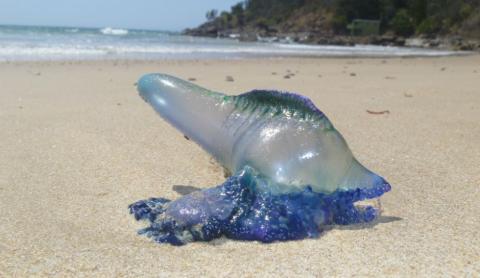Thousands Of Venomous Blue Bottles Spotted Beaching On Australian Shore

An Australian couple has spotted thousands of the venomous blue bottles or also known as Portuguese man o’war washed up on the shore of Bateman’s Bay in New South Wales in Australia on October 27. They described the conglomeration of blue color sea creatures as “alien.”
The couple, Brett Wallensky and Claudia, have seen the poisonous creatures while walking along the Barlings beach. They have also seen some of them in the water while kayaking earlier that day.
Wallensky said that there must have been thousands of them beached and they were all alive and wriggling. He describes them as horrible to look at while wriggling around and try to sting you. He further said that if you fell in there and got that many stings all over you he cannot imagine you would survive.
Meanwhile, Christie Wilcox, a at the University of Hawaii at Manao, told Gizmodo that she would be awed by this sighting. She further said that it is not often that you get to see so many of these incredible animals up close. On the other hand, she warned people not to get too close.
Wilcox explained that blue bottles are not true jellyfish, instead, they are a colonial organism in the same phylum. They are related to jellyfish and have the same potent sting. The stinging cells of blue bottles could remain active for weeks after beaching. So, be careful!
UC News
Thousands Of Venomous Blue Bottles Spotted Beaching On Australian Shore
suman 2017-11-07 05:55:56
SHARE ON FACEBOOK
Thousands Of Venomous Blue Bottles Spotted Beaching On Australian Shore
An Australian couple has spotted thousands of the venomous blue bottles or also known as Portuguese man o’war washed up on the shore of Bateman’s Bay in New South Wales in Australia on October 27. They described the conglomeration of blue color sea creatures as “alien.”
The couple, Brett Wallensky and Claudia, have seen the poisonous creatures while walking along the Barlings beach. They have also seen some of them in the water while kayaking earlier that day.
Wallensky said that there must have been thousands of them beached and they were all alive and wriggling. He describes them as horrible to look at while wriggling around and try to sting you. He further said that if you fell in there and got that many stings all over you he cannot imagine you would survive.
Meanwhile, Christie Wilcox, a at the University of Hawaii at Manao, told Gizmodo that she would be awed by this sighting. She further said that it is not often that you get to see so many of these incredible animals up close. On the other hand, she warned people not to get too close.
Wilcox explained that blue bottles are not true jellyfish, instead, they are a colonial organism in the same phylum. They are related to jellyfish and have the same potent sting. The stinging cells of blue bottles could remain active for weeks after beaching. So, be careful!
Portuguese Man O'War #jellyfishbloom LNP should check it out & see the impact of warming ocean temps. All good? https://t.co/Xtfju4hN6o
— sue travers (@traverselife) November 3, 2017
She said that the mass beaching of the bluebottles on this shore could happen every so often in particular areas when conditions are right. She further explained that these sea creatures could be pushed around by strong winds and strong onshore winds that could shove them into the shallows.
Wilcox thinks that there isn’t anything special about the mass stranding of blue bottles. On the other hand, it is hard to tell, yet she thinks that the location with its strong winds and debris pushed ashore clumps together naturally. It is like in some other places, where seaweeds are all around the beach, while others are clear.
BGR reports that blue bottles are not jellyfish and belong to a class called . This is a collection of independent organisms that living in one unit. This means they work together to survive. They are attached to one another and physiologically incorporated. It is reported that about 10,000 people are stung by blue bottles each year during summer in Australia particularly in the east coast.